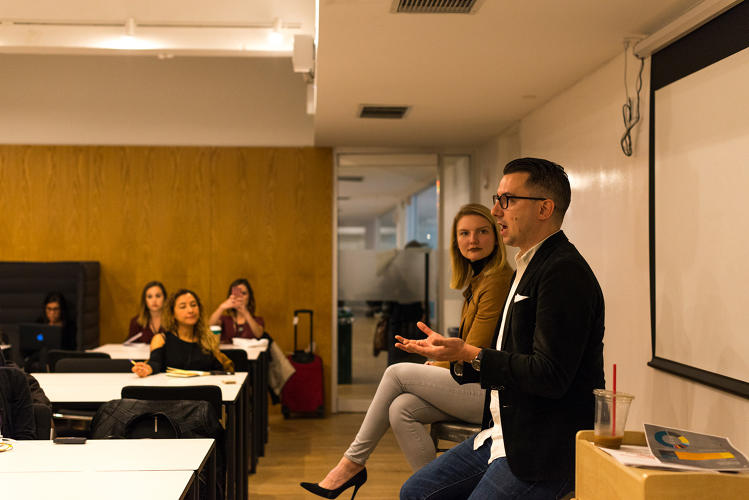How General Assembly Is Helping Companies Increase Diversity
It’s no secret that the technology sector has a diversity problem. Even companies that have publicly pledged to diversify their workforces have struggled to do so: In July, Facebook revealed that just 4% of its employees were Hispanic and 2% black, unchanged from the previous year. The social network blamed the issue on a lack of available talent—a claim that has consistently been disproved.
But the blame may not lie entirely with Mark Zuckerberg. “The practical realities and choices made at the hiring level often supersede very positive and good intentions, even when it’s coming from the most senior executives” said Tom Ogletree, director of Social Impact at General Assembly.
The popular ed-tech startup, which provides training for jobs in the digital economy, is hoping to change that. At the Fast Company Innovation Festival earlier this month, Ogletree and Anna Lindow, VP of Partnerships at General Assembly, or GA, described how the organization is targeting employers’ hiring practices and working with companies to break old habits.
“We’re trying to be influential in changing the way that talent is sourced, assessed, trained, and developed,” Lindow said. “We believe that the system, as it exists today, has limitations. We’re not seeing a diversity of perspectives, and that gives us a world where everything that we’re using has that sameness to it. It doesn’t represent the users.”
Through scholarship programs, partnerships with city, local, and federal governments, and alliances with nonprofits like Black Girls Code, GA is trying to empower low-income and minority communities to pursue careers in tech. But that’s only half the battle. The next hurdle is getting those individuals in the door at tech companies, where old assumptions about college degrees, work experience, and social background often come into play. To “blow up that top 20 school paradigm,” as Lindow put it, she has devised three steps hiring managers can take.

Train More Internally
“Recruiting is expensive,” Lindow said. “Upskilling somebody is cheaper.” Employers often waste time waiting for the perfect candidate to apply for an open position, she explained. They’d be smart to take a risk on other promising applicants and teach them the skills they need later. This is especially true for entry-level employees. “You’re going to teach them your way of doing things anyway,” Lindow said. And by waiting for the dream employee to show up, companies may be passing on bright individuals who have plenty of potential, but simply haven’t had the same educational or employment opportunities.
Assess Talent Differently
Similarly, employers may be passing on candidates who have the skills to succeed, but don’t have a traditional résumé. People who have managed a team at a retail store or a restaurant, for example, may have strong leaderships skills, but are overlooked because of a lack of experience in the tech space. “Translating past experience, especially without a college degree, is really difficult for employers to wrap their heads around,” Ogletree said. He and Lindow suggest evaluating candidates based on their skills, rather than their career or education history. To that end, Ogletree’s team has been developing assessment tests for web development and digital marketing, which would score candidates based on their abilities, potentially eliminating unconscious bias and opening the door for skilled workers, regardless of how they acquired those skills.
Look Somewhere Else
Companies that are struggling to find diverse talent are often searching in the wrong places, according to Lindow. She compared the process to dating: You might look for your partner at a bar, on Tinder, or through a friend. But employers’ methods are akin to using a matchmaker and “limiting criteria down to people who are over six-foot-one, love cats, and hate turtles,” she said. “There’s a few people who are over six-foot-one, love cats, and hate turtles, and they’re already working at Google.” To find a broader pool of candidates, Lindow suggests looking at organizations like General Assembly, as well as seeking out individuals in other fields or industries.
Ogletree and Lindow both stressed that diversity isn’t a buzzword and that these steps aren’t just about checking boxes. “This isn’t just about being able to tell a good story at your company and to get good press.,” Lindow said. “It really is something deeper. It’s about actually being able to do better business because there’s a diversity of perspective. It’s about creating a better world in the long-term.”
General Assembly wants to teach employers how to create more diverse staffs.

“We’re not seeing a diversity of perspectives,” said Anna Lindow (left, with Tom Ogletree) at the Fast Company Innovation Festival.

General Assembly’s Tom Ogletree.

General Assembly’s offices.

General Assembly’s Anna Lindow.

Lindow and Ogletree at the Fast Company Innovation Festival.

Fast Company , Read Full Story
(39)














